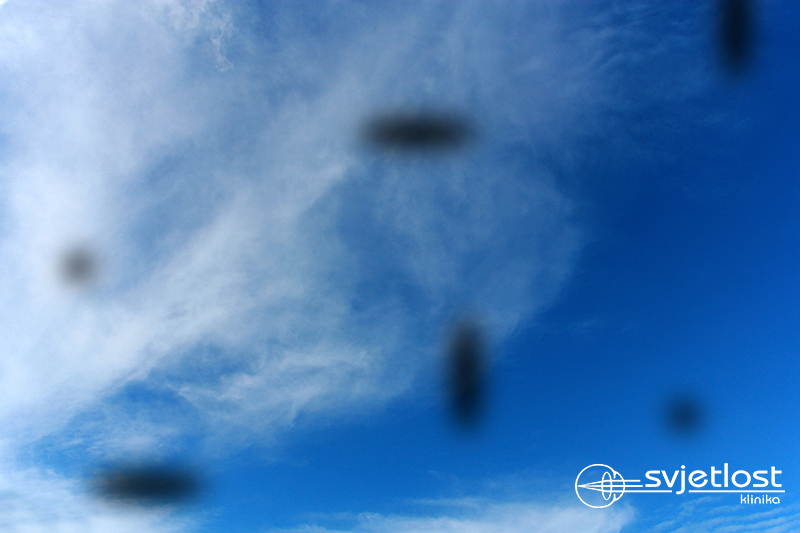What do back eye problem symptoms look like and why is it important to go to examination as soon as possible?
Black dots floating in front of the eye are one of the most common symptoms for patients to appear at the ophthalmologist. Dots or "floaters" do not actually float in front of the eye but float in the middle of the eye, and we are subjectively seeing them in front. They are found in glass, a substance that fills the centre of the eye with a gel structure, made up of 99% water. Over the years, the consistency of the gel changes as a natural physiological process and collagen deposits form a density that appears as "eye floaters”. This phenomenon is completely harmless and does not endanger any visual impairment.
However, if there are many floaters, and some side effects such as redness, vision stimulation or deterioration, then there may be some more serious process, inflammation or bleeding in the eye, and you should contact your ophthalmologist.
And flashes in front of the eyes are also a common symptom that leads us to the eye examination. We have described how, with years, glass, ie the gel that fills the central part of the eye, is structurally changing. Because of its physiological processes, it can be separated from the back of the eye. This separation will lead to the appearance of flashes that appear with eye or head movements. This is a harmless symptom.
However, flashes in the eyes may also occur in retinal detachment, and this is an emergency and requires an ophthalmic treatment. The retina is a very thin visual membrane that lends the inner part of the eye, consists of 120 million sensory cells and receives visual stimulus. Tear is caused by degenerative changes, somewhat more often in short-sighted persons. It is recommended that a short-sighted person at least once a year carries out a background eye examination with the pupil dilation. In the case of a retinal tear, it’s necessary to urgently “weld” hole in the retina with the laser to prevent retinal ablation due to liquid overflow for the glass.
The main symptom of retinal detachment is the appearance of dark curtains or "blinds on the eye" as these patients most often describe. Detachment is a disorder in which retina separates from the layer underneath. Most often, it occurs because of a break that allows the fluid in the eye to get behind the retina. Retinal detachment must be urgently operated because the sensory cells of which it’s made are damaged within 48 hours. The earliest operative eye, the better visual recovery.
Which of these symptoms are confusing, and which aren’t, which require treatment and which don’t, you’ll find out best from your ophthalmologist after detailed eye background examination. If you notice any of these symptoms, specialized experts retinologists of Svjetlost Ophthalmology Clinic are available.
Dr. Vesna Cerović, ophthalmologist
However, if there are many floaters, and some side effects such as redness, vision stimulation or deterioration, then there may be some more serious process, inflammation or bleeding in the eye, and you should contact your ophthalmologist.
And flashes in front of the eyes are also a common symptom that leads us to the eye examination. We have described how, with years, glass, ie the gel that fills the central part of the eye, is structurally changing. Because of its physiological processes, it can be separated from the back of the eye. This separation will lead to the appearance of flashes that appear with eye or head movements. This is a harmless symptom.
However, flashes in the eyes may also occur in retinal detachment, and this is an emergency and requires an ophthalmic treatment. The retina is a very thin visual membrane that lends the inner part of the eye, consists of 120 million sensory cells and receives visual stimulus. Tear is caused by degenerative changes, somewhat more often in short-sighted persons. It is recommended that a short-sighted person at least once a year carries out a background eye examination with the pupil dilation. In the case of a retinal tear, it’s necessary to urgently “weld” hole in the retina with the laser to prevent retinal ablation due to liquid overflow for the glass.
The main symptom of retinal detachment is the appearance of dark curtains or "blinds on the eye" as these patients most often describe. Detachment is a disorder in which retina separates from the layer underneath. Most often, it occurs because of a break that allows the fluid in the eye to get behind the retina. Retinal detachment must be urgently operated because the sensory cells of which it’s made are damaged within 48 hours. The earliest operative eye, the better visual recovery.
Which of these symptoms are confusing, and which aren’t, which require treatment and which don’t, you’ll find out best from your ophthalmologist after detailed eye background examination. If you notice any of these symptoms, specialized experts retinologists of Svjetlost Ophthalmology Clinic are available.
Dr. Vesna Cerović, ophthalmologist


